We’d like to remind Forumites to please avoid political debate on the Forum.
This is to keep it a safe and useful space for MoneySaving discussions. Threads that are – or become – political in nature may be removed in line with the Forum’s rules. Thank you for your understanding.
The MSE Forum Team would like to wish you all a very Happy New Year. However, we know this time of year can be difficult for some. If you're struggling during the festive period, here's a list of organisations that might be able to help
📨 Have you signed up to the Forum's new Email Digest yet? Get a selection of trending threads sent straight to your inbox daily, weekly or monthly!
Has MSE helped you to save or reclaim money this year? Share your 2025 MoneySaving success stories!
Economy 10 timings and move to smart metering (Merged)
Comments
-
Thanks. I'm about to crawl back under my rock, because this setup is beyond me. It looks as if Octopus have devised a cunning scheme to get round the fact that the RTS system is beyond what Kraken can handle, and I just don't see how it works. There are (if I look very closely) two live cables from the meter, which is what I'd expect if there is a separate time-switched circuit for heating. This is what the RTS will be controlling and the meter will be recording on one of its registers. However, it looks as if everything else is on all the time.
I picked out the salient bits about the other MPAN earlier, but this one has me baffled. For a start, it's PC01 - meaning single rate. The other was PC02 - two rate. This means there is only one register for all usage passing through this virtual meter, which doesn't tie in at all with the MTC (587) and SSC (300) which would normally have two TPRs - peak and offpeak. There is only one, 01080, which is a Day ToU with the hours given (Monday-Friday 07:30-19:30). I honestly have no idea how that works for billing; it could be that the meter has three registers: one for Heating, one for Day (everything other than heating during the day) and the third for Night. Are there three readings you can take?
So, some hours later I'm still struggling with this. However, my Google-fu did turn up a ten-year-old contribution from someone who says and sounds as if he knows what he's talking about, which makes a change. Have a look: One meter to my property, 2 MPANs and possible being over-charged?! - National Consumer Service. I note he claims that "having 2 MPANs is a workaround that saved a bucket load of industry costs." So it isn't unheard of, but its history goes back half a century. It will all be so much simpler with a smart meter. Now you'll have to do your sums to work out which tariff would work best for you once the RTS has been laid to rest.I'm not being lazy ...
I'm just in energy-saving mode.0 -
Thanks Ildhund for your support with this.
I think I have solved the mystery with the help of various forum members BUT I would really appreciate it if someone could confirm my working out below...I stand to be corrected.
So I originally posted as follows:
I need to know if the 'Eco 10' heater timings that we have been given by Octopus look as crazy as I think they are, to those with some experience. We have an RTS telemeter, two MPANS and three readings, supplying what used to be known as ECO10. We have storage heaters. The current supplier is Octopus and they have us on Octopus Flex tariff with two standing charges. Octopus have provided us with and confirmed the following timings:
Off peak, weekdays 19.30 - 07.30hrs and Sat/Sun 00.00 - 24.00hrs
Heating Off Peak, weekdays 00.00 - 07.00, 13.00 - 16.00, 20.00 - 24.00, Sat 13.00 - 24.00 and Sun 00.00 - 24.00- QrizB suggested that the timings aren't actually Eco10 and I think he's right.
- QrizB went on to suggest that it looks closest to Ovo's Flexiheat tariff (previously SSE) and I think he's right.
- Ildhund then translated some of the codes on the data page which I uploaded and suggested that TPR 01082 correlated with the heater timings provided.
- I googled TPR codes and found an engie.co.uk table showing the times...https://www.engie.co.uk/wp-content/uploads/2024/12/TPR_Reference_sheet_2022.pdf

- Ildhund added, "I suppose that this means the timings are a framework within which the heating circuit can be activated, but with the precise switching times controlled by the radio signal to give - say - 10 hours of charge a day as decided by the DNO."
- I googled TPR SSC and SSE and came across a spreadsheet (PDF) from Indigo Power with the following information:
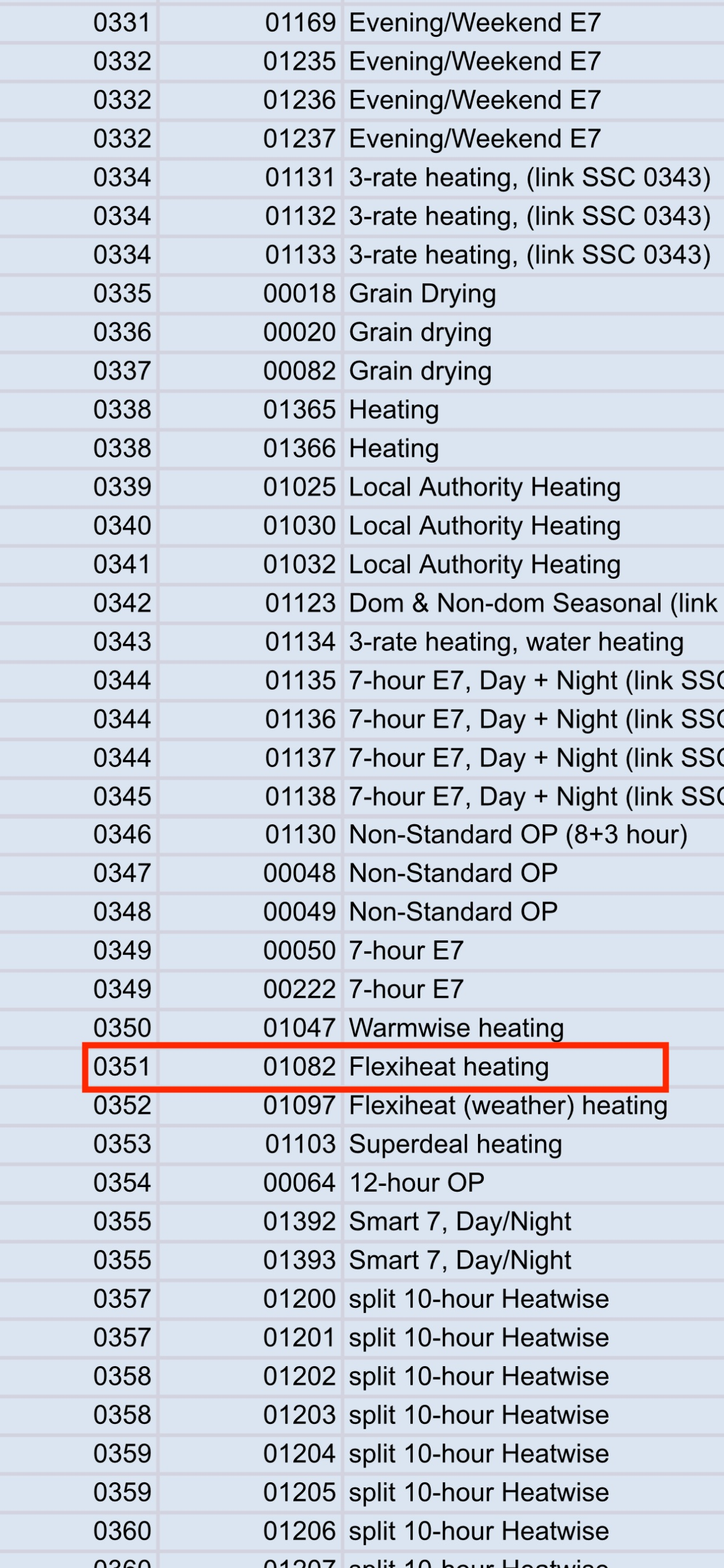
- I googled Flexiheat and found this from Ovo:
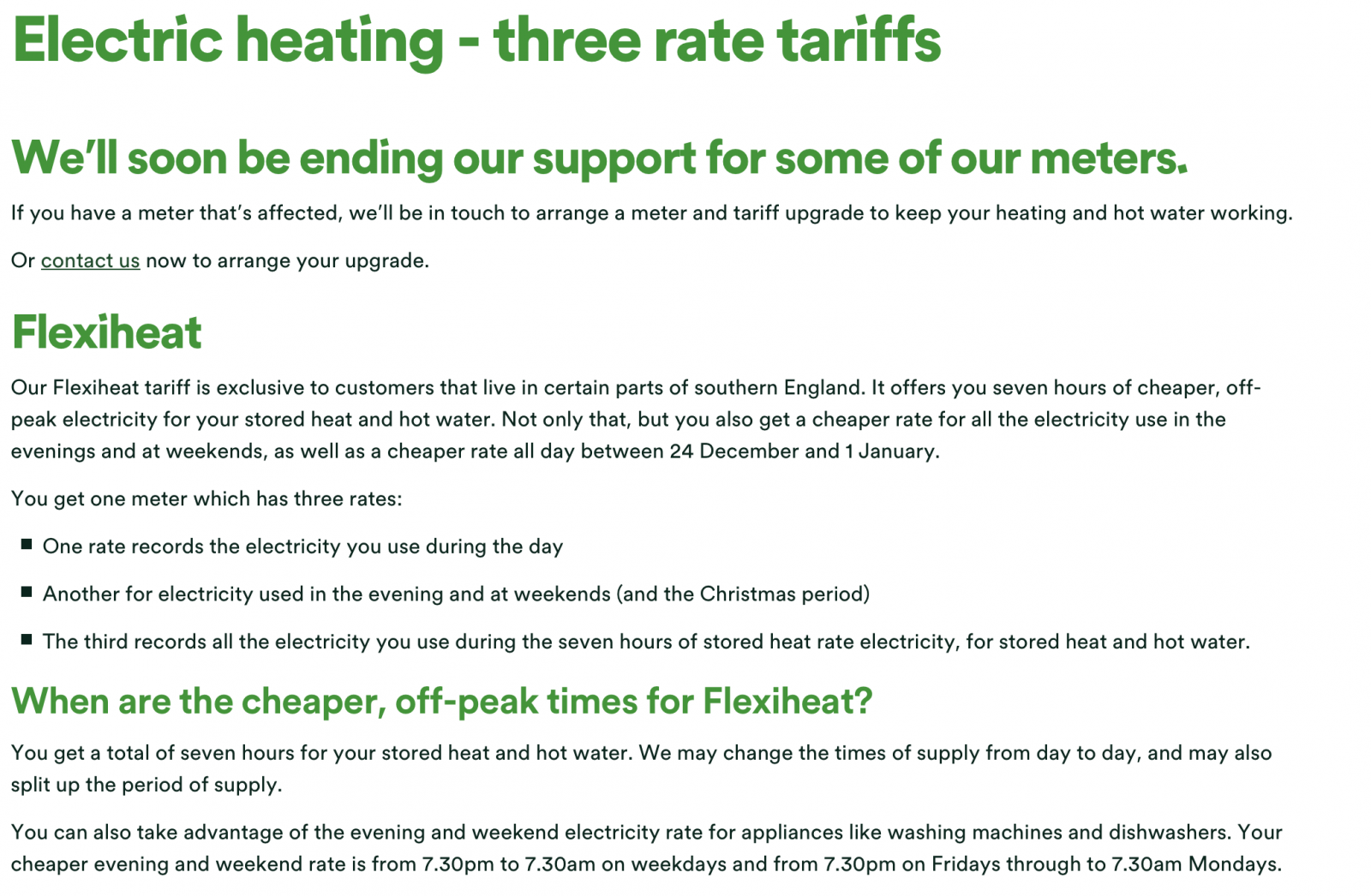
- and found this from Switch-plan from 2022 (I think):
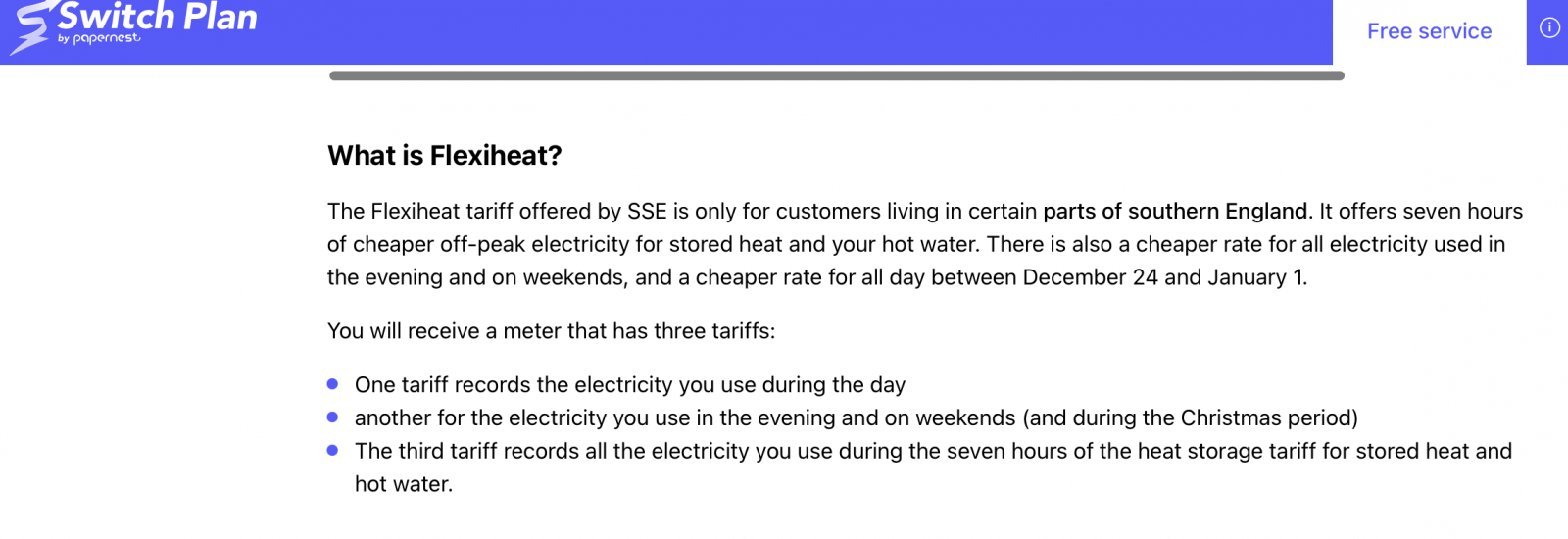
- My conclusion is that the timings provided by Octopus are not the actual timings of the tariff or when the heater circuit is energised, as they have insisted (as suggested by Ilhund) I'm betting that the actual timings are those quoted for Flexiheat.
- The meter was installed by SSE and programmed with Flexiheat timings. Ovo took over the tariff - they were the previous supplier at our property. Octopus took over the supply from Ovo and appear to have seriously mislead us since we raised this query in 2022, if my thinking here is proved to be correct.
- Can anyone confirm the logic above?
0 -
Looks good to me. I'm ashamed to say I didn't think of looking up OVO's complex tariffs to find one that matched yours, so take two house points for initiative!
There are still a couple of questions:- Have you found the three registers?
- Have you submitted any readings recently?
- Could we see a recent bill to see how the readings (estimated or not) are shown and the prices allocated?
I'm not being lazy ...
I'm just in energy-saving mode.0 -
Hi,
I think its a gold star for everyone if it's correct...
1. By registers, you presumably mean (excuse my lack of knowledge) the three readings that one can take from the meter? If so, yes. There are three readings on the meter, which I refer to as Peak, Off Peak and Heat but they are not labeled this way on the meter or the bill.
2. This is complicated...The primary account holder has a disability (I'm essentially their representative...I don't live at the address) and Octopus therefore agreed to read the meter. Unfortunately this has been inconsistent and on several occasions, they have not read from/submitted the correct register in all cases and this has resulted in a long period on the Heat register without a reading. I did get three readings yesterday though to submit.
3. The billing is pretty impenetrable. Some bills have both MPANS, whilst others are split into two bills with one MPAN each. The dates are also inconsistent, I think due to changes in the rates between billing dates? (because its a variable tariff) But I can upload a couple with some redaction.
Obviously, the Flexiheat timings do not correlate with the times provided by Octopus exactly but are within the parameters of the timings and I think its highly likely what is going on here...This is based on your suggestion that the TPR (which is what Octopus have quoted) is not the final word on timings. The RTS signal, specific combination of SSC and TPR and the DNO are what define the actual timings. Interestingly, the Flexiheat appears to be called Flexi...because the times for the heating circuit are not defined but can flex according to the supplier's wishes (within the parameters of the TPR).
IF all of this is correct and the meter is acting according to the timings of the Flexiheat tariff, then Octopus have provided a very poor service, in not providing the actual timings...This has caused confusion and not helped the customer to effectively manage their energy usage.0 -
simfrend said:IF all of this is correct and the meter is acting according to the timings of the Flexiheat tariff, then Octopus have provided a very poor service, in not providing the actual timings...This has caused confusion and not helped the customer to effectively manage their energy usage.It's entirely possible that Octopus don't know the Flexiheat timings and have no influence over them.When Flexiheat was launched (yes I'm that old) the DNO was the regional electricity company Southern Electric. Southern Electric would have been the organisation setting the RTS timings. Southern Electric's network operations arm is now part of SSEN, while SSE's remaining domestic customers were all moved to OVO. Exactly what organisation controls your specific RTS timings is unclear, but IMHO the chances of it being Octopus are near-zero.There might not be anyone left with the ability to set them, and they'll be stuck at whatever settings were last sent to the RTS transmission folk.But honestly, this is all a digression. It makes very little difference what your RTS timings are, since the replacement smart meter *will* be configurable by your supplier to match whatever tariff you choose.N. Hampshire, he/him. Octopus Intelligent Go elec & Tracker gas / Vodafone BB / iD mobile. Ripple Kirk Hill Coop member.Ofgem cap table, Ofgem cap explainer. Economy 7 cap explainer. Gas vs E7 vs peak elec heating costs, Best kettle!
2.72kWp PV facing SSW installed Jan 2012. 11 x 247w panels, 3.6kw inverter. 34 MWh generated, long-term average 2.6 Os.0 -
Hi QrizB and thanks for your support.QrizB said:simfrend said:IF all of this is correct and the meter is acting according to the timings of the Flexiheat tariff, then Octopus have provided a very poor service, in not providing the actual timings...This has caused confusion and not helped the customer to effectively manage their energy usage.It's entirely possible that Octopus don't know the Flexiheat timings and have no influence over them.When Flexiheat was launched (yes I'm that old) the DNO was the regional electricity company Southern Electric. Southern Electric would have been the organisation setting the RTS timings. Southern Electric's network operations arm is now part of SSEN, while SSE's remaining domestic customers were all moved to OVO. Exactly what organisation controls your specific RTS timings is unclear, but IMHO the chances of it being Octopus are near-zero.There might not be anyone left with the ability to set them, and they'll be stuck at whatever settings were last sent to the RTS transmission folk.But honestly, this is all a digression. It makes very little difference what your RTS timings are, since the replacement smart meter *will* be configurable by your supplier to match whatever tariff you choose.
You're right that a replacement meter will likely solve all of these issues moving forward.
However, the customer has been struggling with this issue since 2018 and it has taken more than 6 years to get close to understanding what the timings are in her property. It's not just possible but almost certain that Octopus didn't know that the Flexiheat timings applied - they have consistently referred to the meter and timings as an "ECO10 setup" which it is almost certainly not and is a red herring.
Once I was equipped with some understanding of the codes on the data sheet (TPR and SSC) it wasn't difficult to find this from SSE https://www.sseandme.co.uk/file/SHP-Schedule-of-Charges-and-Other-Tables-April-2022 and I find it hard to believe that Octopus would not be able to access information such as this, far more readily than me- I think it is actually the very first google result if you put in "SSC 0351 SSE"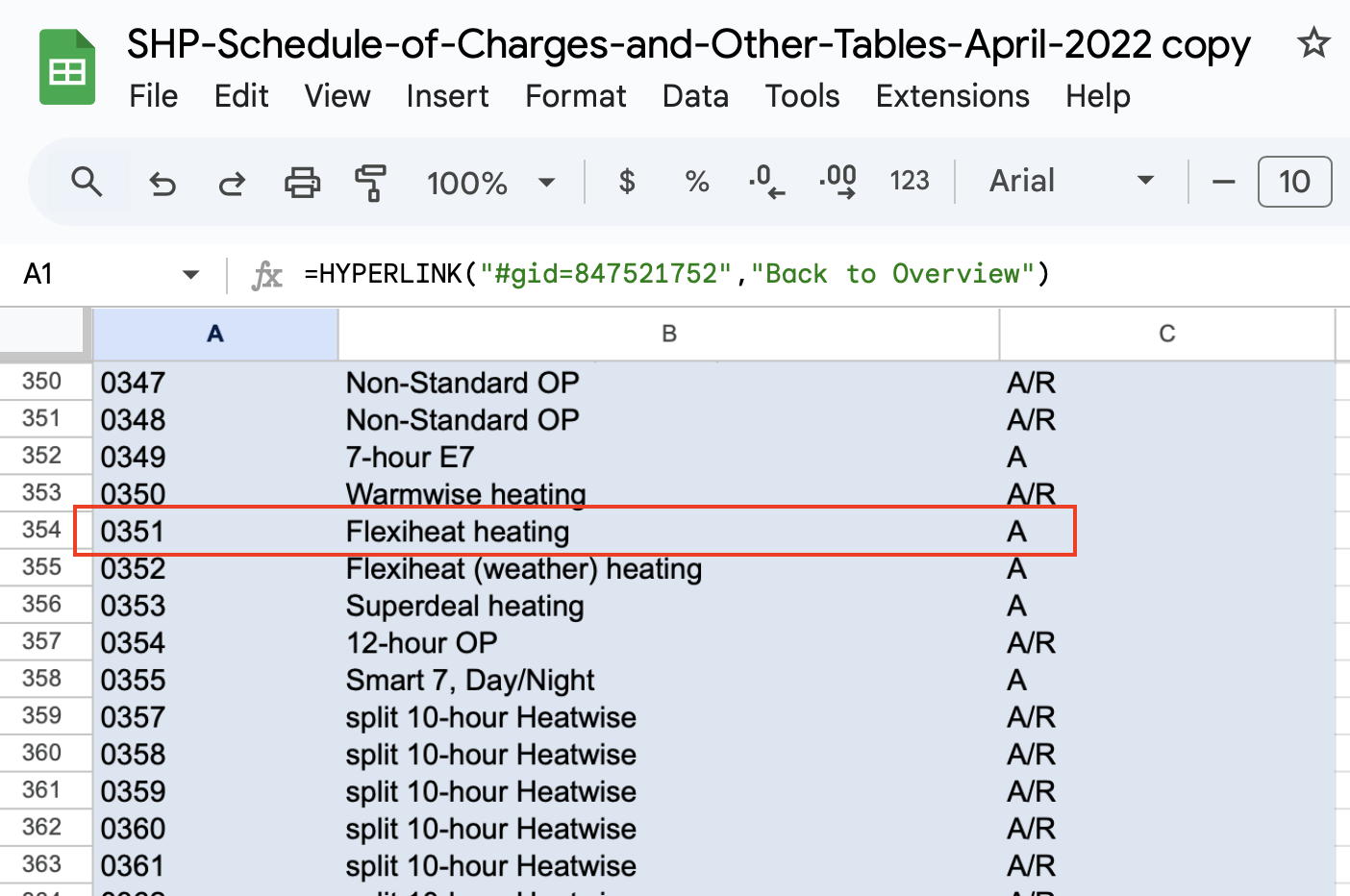
If Flexiheat are the actual timings that are in place, then Octopus should have found them out and communicated them to the customer in 2018...surely they are the ones with the industry knowledge and contacts to look into it and have the responsibility to do so? How else is a customer supposed to effectively manage heating and peak off peak usage if they don't know what times they apply? Knowing the actual timings that apply also make cost comparisons with other available tariffs more realistic and less of a guess.
I'm not really concerned with Octopus's ability to influence the timings as first installed. The main quest was always to find out what the actual timings were - without knowing what the timings are it's difficult to decide if they require changing or indeed if a new tariff would be better etc.
Hopefully these are now confirmed (as far as they can be with it being 'Flexi") unless someone points out some flaw in the conclusions that I have come to...any more confirmation/contradictory theories grateful received.
Thank you to everyone who has contributed to the thread...It's been an education and extremely helpful.0 -
The whole point of RTS is that electricity is delivered at times determined by the DNO. This was (and still is in many areas) to avoid, say, customers powered from the same substation or group of substations all having their substantial heating load on at the same time, leading to potential grid overload. This meant that although one customer had heating power from 6am to 9 am (with other slots of course), his neighbour might get power from 9am-noon. We're seeing more of this sort of problem as home-charging of EVs becomes more widespread - there are lots of bits of network that just can't cope. DNOs even produce maps showing problem locations, not only for high demand but also for ever-increasing supply as people want to sell solar power to the grid.
That's why no-one can tell you what the precise timings are on your RTS-controlled heating circuit. They may even be variable as the DNO tries to balance its network, so it could be 2pm - 5pm one day and 3pm to 6 pm the next. Since it's all metered and charged at the same rate, the variable times have no effect on cost. Any variation in comfort is a cross these customers have to bear, I'm afraid.
I'm not being lazy ...
I'm just in energy-saving mode.0 -
Ildhund said:Looks good to me. I'm ashamed to say I didn't think of looking up OVO's complex tariffs to find one that matched yours, so take two house points for initiative!
There are still a couple of questions:- Have you found the three registers?
- Have you submitted any readings recently?
- Could we see a recent bill to see how the readings (estimated or not) are shown and the prices allocated?
3 - MPAN for Heating
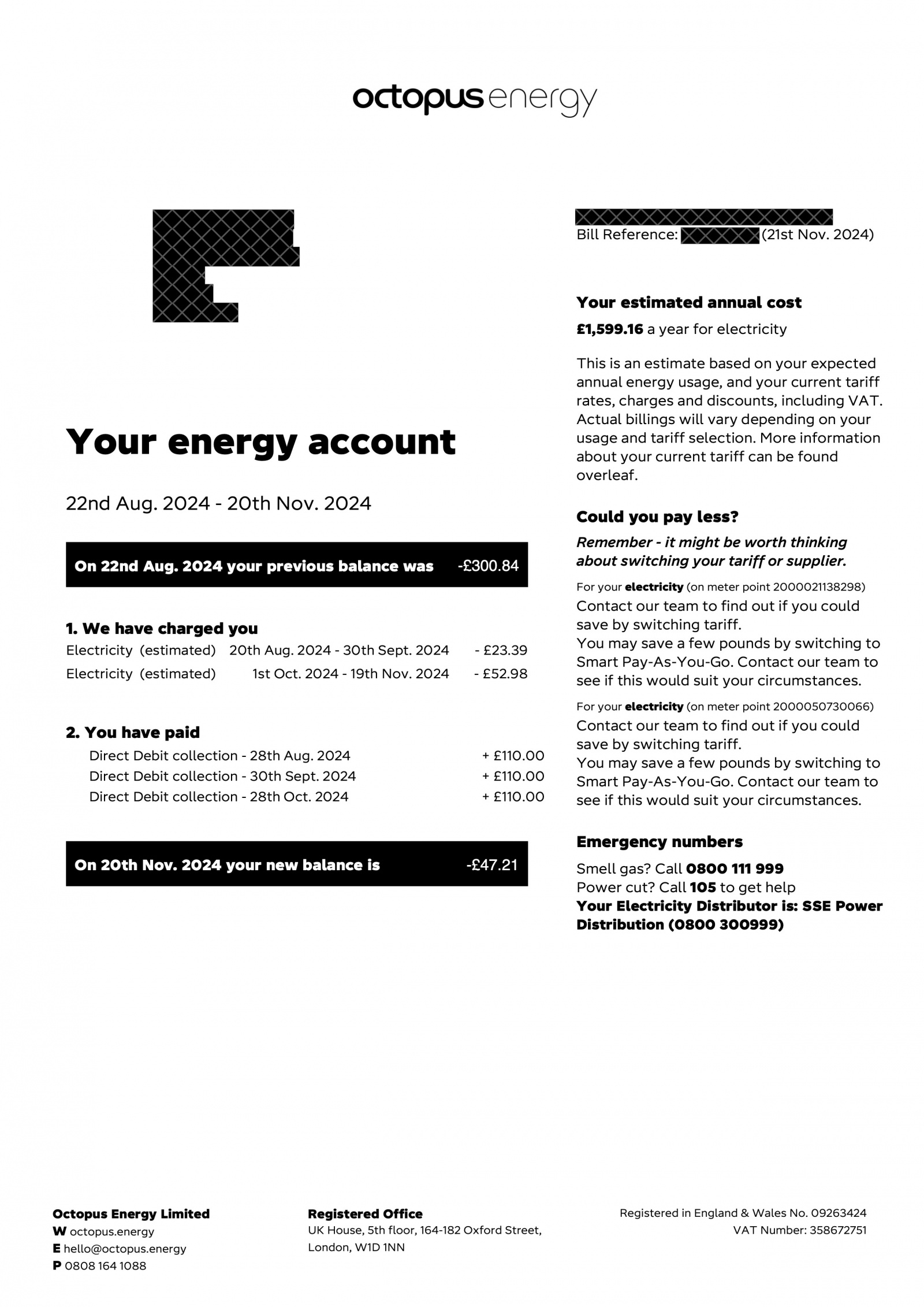
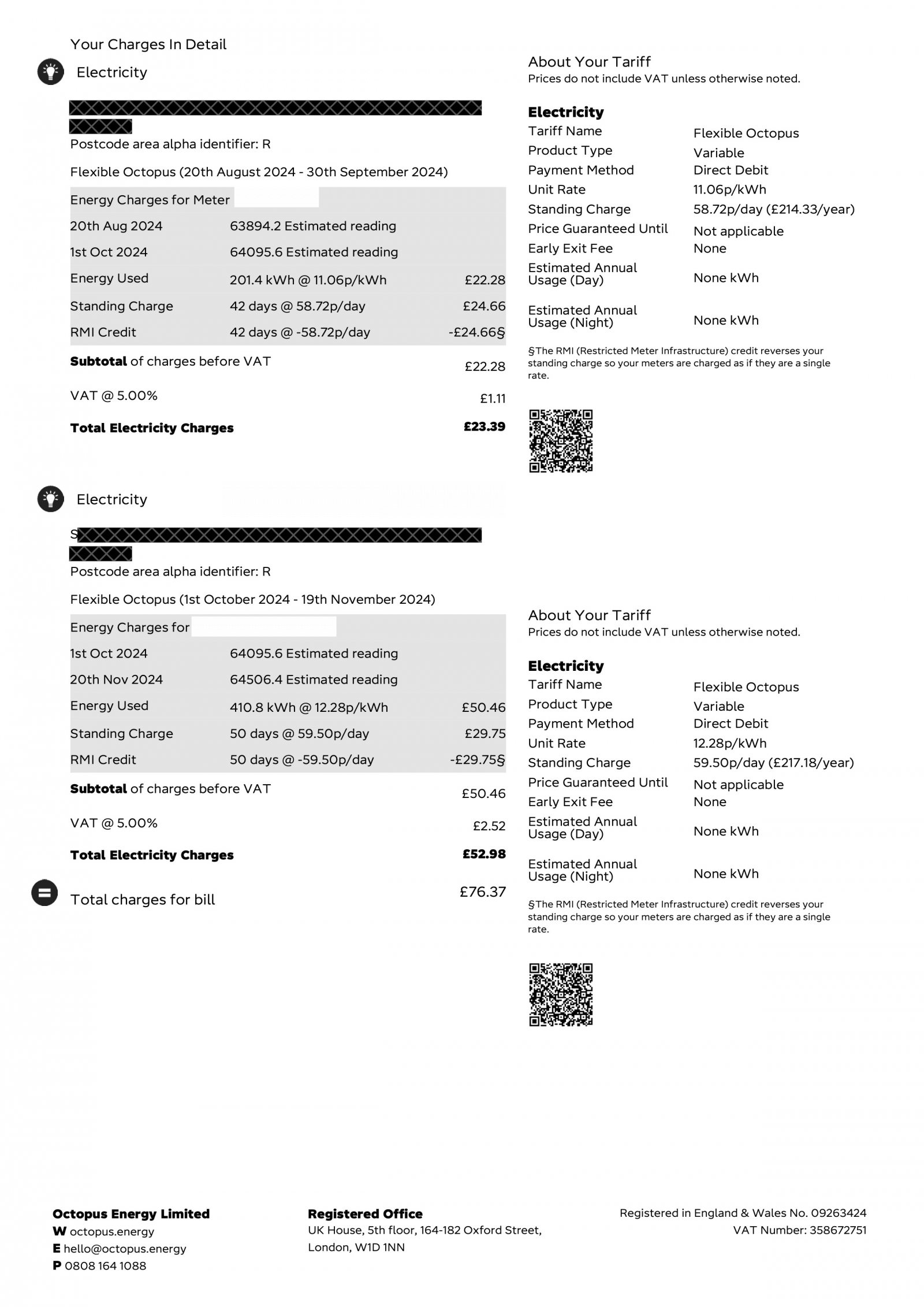
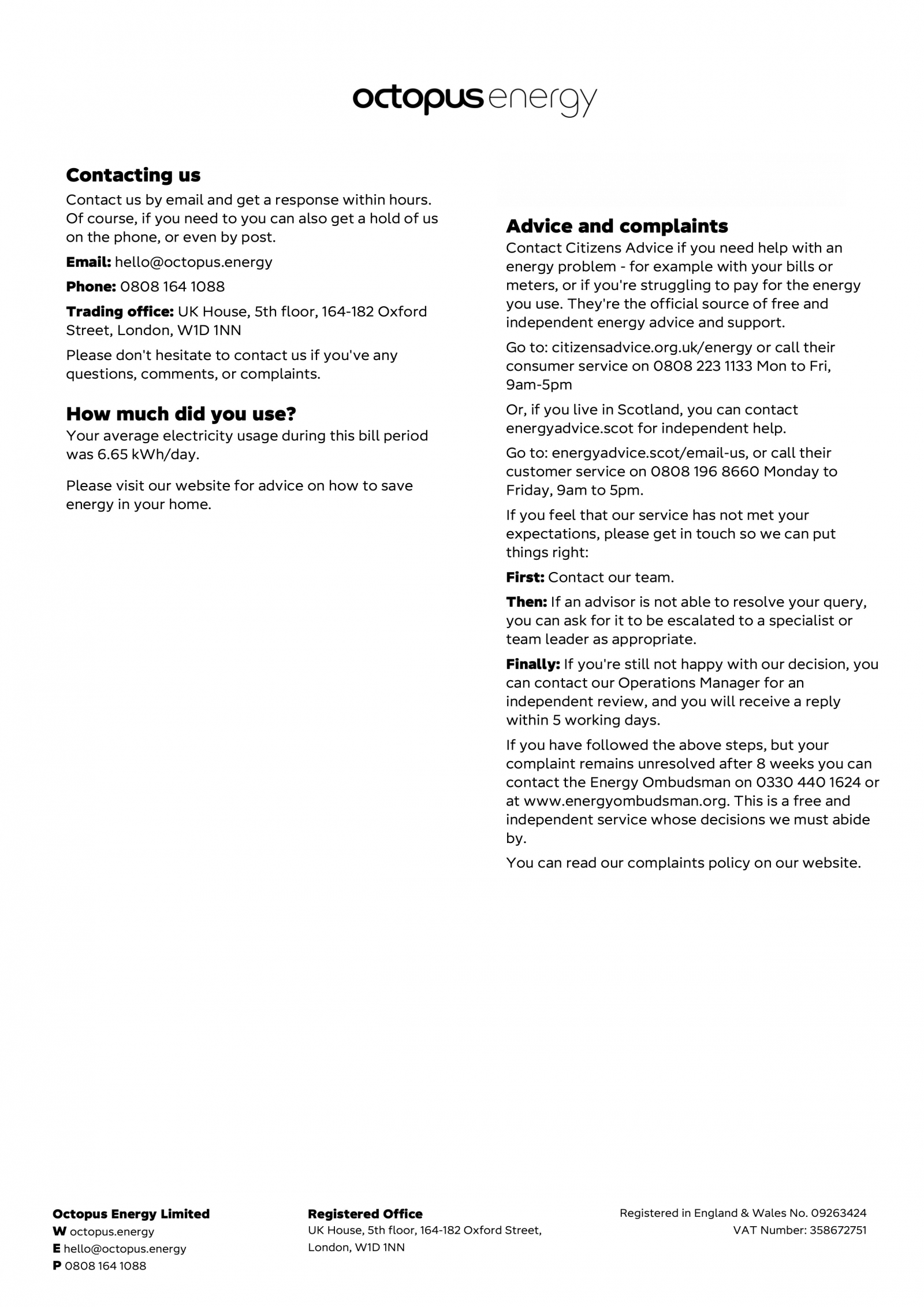
0 -
Hi,Ildhund said:The whole point of RTS is that electricity is delivered at times determined by the DNO. This was (and still is in many areas) to avoid, say, customers powered from the same substation or group of substations all having their substantial heating load on at the same time, leading to potential grid overload. This meant that although one customer had heating power from 6am to 9 am (with other slots of course), his neighbour might get power from 9am-noon. We're seeing more of this sort of problem as home-charging of EVs becomes more widespread - there are lots of bits of network that just can't cope. DNOs even produce maps showing problem locations, not only for high demand but also for ever-increasing supply as people want to sell solar power to the grid.
That's why no-one can tell you what the precise timings are on your RTS-controlled heating circuit. They may even be variable as the DNO tries to balance its network, so it could be 2pm - 5pm one day and 3pm to 6 pm the next. Since it's all metered and charged at the same rate, the variable times have no effect on cost. Any variation in comfort is a cross these customers have to bear, I'm afraid.
That all make perfect sense but the situation is slightly different to your examples.
According to the details of Flexiheat, the timings of peak and off peak don't vary at all. The precise timings of the heating register on the other hand, can be varied from day to day (presumably for the reasons that you describe) but will always total 7 hours per day.
The examples that you provide compare the same number of hours but delivered at different times of the day, like the heat register of Flexiheat. However, the issue here is that Octopus continue to insist that the heating is actually on permanently between 13.00 Saturday and 07.30 on Monday totalling 42 hours...this always seemed wrong to me (hence my original questions) but if we are on Flexiheat, it is entirely misleading as it will actually amount to 14 hours in total (even if it varies as to when it is delivered.)
Likewise, Octopus insist that the heating is on for 14 hours per day, during the week when in fact, if it's Flexiheat, it will be on for only 7hrs per day. The variance of the precise timings pales into insignificance next to this.
Ultimately, if it is proven that the timings are as per Flexiheat, then Octopus could and should have provided these details (which are freely available when you know what you're looking for) at the very start of the supply.0
Confirm your email address to Create Threads and Reply

Categories
- All Categories
- 353K Banking & Borrowing
- 253.9K Reduce Debt & Boost Income
- 454.8K Spending & Discounts
- 246.1K Work, Benefits & Business
- 602.2K Mortgages, Homes & Bills
- 177.8K Life & Family
- 260K Travel & Transport
- 1.5M Hobbies & Leisure
- 16K Discuss & Feedback
- 37.7K Read-Only Boards




